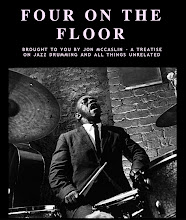Wednesday, October 28, 2015
Stick Control Around The Drums
I stumbled across this exercise yesterday while I was practicing and trying to think of interesting ways to split up paradiddles around the drum set (I was listening to Ed Blackwell that afternoon and he inspired me to do so…) I came up with a simple exercise that yielded some interesting patterns and decided to expand on it by using George Lawrence Stone's Stick Control as well.
I'll do my best to explain this simple method without the benefit of notated parts. Wish me luck! (although you can also refer to the first page of Stick Control above…)
"Stick Control Around the Drums (with a nod to Alan Dawson!)":
1) Play each line as eighth-notes with the hi-hat on beats 2&4 (or on all four quarter notes)
2) Divide each bar into TWO equal parts (ie. beats 1 & 2 and 3 & 4) and use the following orchestrations:
Beats 1+ 2+ : R = ride cymbal & bass drum, L = small tom
Beats 3+ 4+ : R = floor tom, L = snare drum
3) Then reverse the order of the orchestration :
Beats 1+ 2+ : R = floor tom, L = snare drum
Beats 3+ 4+ : R = ride cymbal & bass drum, L = small tom
I also found myself messing around with this version:
Beats 1+ 2+ : R = ride cymbal & bass drum, L = snare drum
Beats 3+ 4+ : R = floor tom, L = small tom
(then try the reverse version as #3)
I came up with many interesting combinations that I hand't really considered before (always a good thing!) and I'm sure you could also come up with some more interesting variations of your own based on this as well.
(just wait until you get to the pages of Stick Control that use triplets!)
I hope this makes sense...
Friday, October 23, 2015
Dan Weiss Plays Tristano
I think this kind of creative ingenuity is brilliant and, if more people do this and try this sort of thing, will inevitably serve to expand the creative potential of the drum set as a musical instrument:
Monday, October 19, 2015
Morgan Childs "On The Street of Dreams"
I've really been enjoying Toronto Jazz drummer Morgan Childs' latest offering over the past few months, a hard swinging and very enjoyable quartet outing featuring Childs on drums with several of my favourite Canadian Jazz artists including Kelly Jefferson on tenor saxophone, Dave Restivo on piano and Jon Maharaj on bass.
Morgan was nice enough to take some time out of his busy schedule to answer a few questions about his latest project and his music:
1) How did this recording project come about?
5) Half of the tunes represented on this recording are your own original compositions. Can you speak to your influences and a process as a composer?
--------------
To learn more about Morgan's music check out his website www.morganchildsmusic.com and buy his album at www.cdbaby.com/Artist/MorganChilds.
Wednesday, October 14, 2015
Shirley Scott with Art Taylor
Some seriously groovy and swinging music today featuring the great Art Taylor on drums with Shirley Scott on B3 Hammond Organ and Harold Vick on tenor saxophone:
Wednesday, October 7, 2015
Kenny Plays Yaiba
Anyways, here's an entertaining one of the "Jazz Maniac" himself, Kenny Washington, demonstrating his new Canopus Yaiba drums ("Don't walk, RUN!!!" he says...):
(Thanks to Zion Afuang who passed along this gem via the Facebook.)
And just for kick's here's another clip of KW in action with the Bill Charlap trio from a recent hit in Paris at the Duc du Lombards:
*EDIT*
And here's Kenny playing another, different set of Canopus Neo-Vintage drums:
Thursday, October 1, 2015
Ben Wendel & Jeff Ballard: The Seasons
More excellent saxophone and drum duet action today from Ben Wendel, this time featuring Jeff Ballard in Wendel's excellent on-going series The Seasons:
Subscribe to:
Posts (Atom)






















